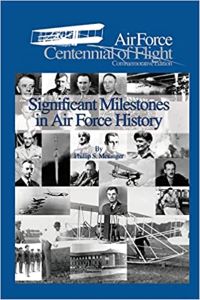- AFHF Member Authors
Significant Milestones in Air Force History
by Phillip Meilinger
The concept of flight has fascinated man for millennia. The minds of the ancients invented winged gods and goddesses who lived in the heavens or who traversed it in chariots of gold. The restless brilliance of Leonardo da Vinci designed a flying machine five centuries ago; but his vision, as well as those of many who followed, relied on the muscle power of man to make it work. That would not be enough. A mechanical engine would be necessary. Flight would have to be a byproduct of the industrial revolution. In the meantime, man turned to an alternative means of reaching into the sky—balloons. The first balloon ascent occurred in Paris in 1783—the same year the United States gained its independence from Britain, ratified, coincidentally, by a treaty signed in Paris. Over the next century and a half, balloons and their more steerable brethren, dirigibles or rigid airships, were designed and flown in various countries worldwide. But the notion of heavier-than-air flight in a winged vehicle would not go away. Throughout the latter half of the nineteenth century a number of aviation pioneers studied the problem of flight from an increasingly scientific viewpoint. All recognized that two primary problems needed to be overcome—power and directional control. Someone would have to build an engine that was both powerful enough and light enough to lift an airplane and its pilot into the air and sustain it. The internal combustion engine was the obvious solution, but early motors that were made for automobiles and dirigibles were too heavy— they delivered too little horsepower for their weight. Related to this issue was the need for a suitable airscrew, or propeller, to attach to the engine that would propel the craft through the air. The second problem, controlling an airplane in flight, seemed even more difficult. Both of these problems were solved by two hard-working and taciturn bicycle mechanics from Dayton, Ohio. (Their bicycle shop has since been restored and moved to Greenfield Village near Detroit). Orville and Wilbur Wright, sons of a minister, designed and built their own gasoline engine that was not a spectacular device, but adequate for their purpose. It weighed about 200 pounds and delivered 12 horsepower. Just enough. Also important, the brothers designed and built their own propellers. Their solution to the directional control issue was more ingenious. Learning from the flight of birds, the brothers saw that birds made subtle changes in their wingtips, bending them up or down slightly, and this allowed them to turn quickly and gracefully. The Wrights therefore rigged up a series of cables and pulleys that connected the wings of their craft to levers where the aviator would lie (later sit). When manipulating the levers, the pilot would actually twist the shape of the wings themselves—much like a bird alters the shape of its wings—allowing the craft to turn. This “wing warping” method was soon replaced by more practical devices—movable rudders and ailerons. The latter consisted of a separate airfoil usually attached to the outer portion of a wing: but the basic principle the Wrights invented was sound. On Dec. 17, 1903, at Kitty Hawk, North Carolina, the Wright brothers made history’s first powered flight in a heavier-than-air machine that incorporated their two scientific breakthroughs. Their invention, the airplane, changed the world. As the centennial of their momentous achievement approaches, the United States Air Force has established the Centennial of Flight Office, whose mission is to celebrate airpower and the Wright brothers’ historic event. One of their projects is this pamphlet series, which will trace the most significant people, events, technologies and ideas in the history of the United States Air Force.

